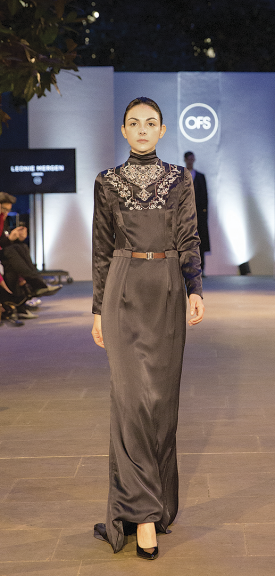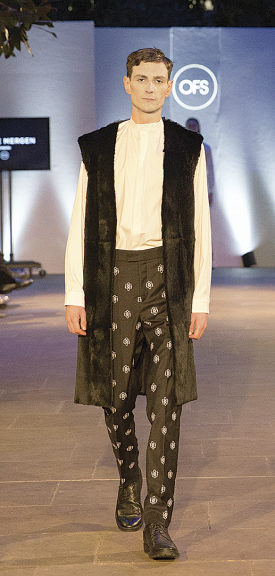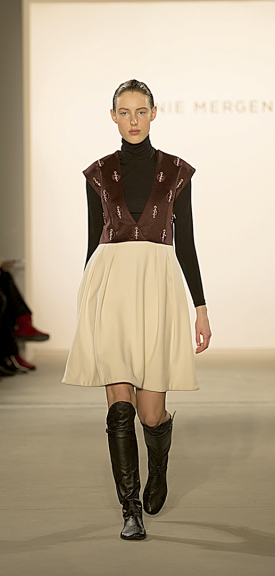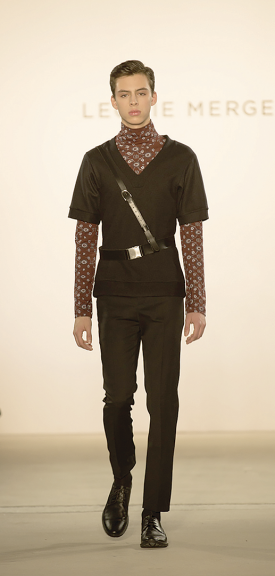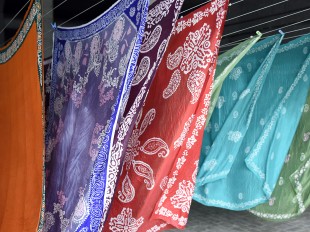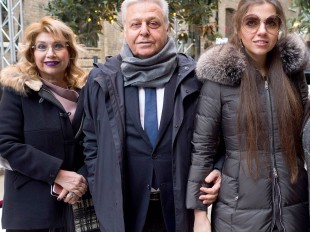The 25-year-old Dorsten-born fashion designer Leonie Mergen is one of the emergent talents of the Berlin scene. A stickler for detail, she is a graduate from the Berlin International University of Art for Fashion (ESMOD) and has undertaken internships at some of the leading Berlin fashion houses, including EDSOR-Berlin, Hellmann Menswear and Dawid Tomaszewski.
Her second collection – the Karabakh-Collection – comprises a series of pieces inspired by the traditional attire of the Azerbaijani Karabakh region, which remains under Armenian occupation. In late January and early February, this hit the respective runways of Berlin and London with the support of the TEAS offices in Germany and London, appearing at the Mercedes-Benz Berlin Fashion Week; L’Oréal Professionnel showcase for 200 L’Oréal representatives, also in Berlin; and London Fashion Week, which led to its inclusion on the Vogue UK website (http://bit.ly/voguekarabakhcollection). Neil Watson caught up with Leonie amidst the contemporary minimalist splendour of the Bulgari Hotel in Knightsbridge to learn more:
VoA - How did you feel the launch at London Fashion Week was received?
I think it was fantastic. The location in Devonshire Square was beautiful and it was a whole new experience, as the Berlin event took place inside, whereas the London runway is outside, in a courtyard.
What originally stimulated your interest in entering the fashion industry?
I started sketching concepts for fashion at a very young age, and by the age of around 10 I realised that my future lay in the fashion industry. When I started sketching, my objective was to tailor some clothes for myself and for my dolls! I used the sewing machine belonging to my grandmother to sew the clothes.
What has been the critical response to the Karabakh-Collection, to date?
I have not received any reviews from the British fashion media, so far, but I am pleased to say that the German media has been uniformly positive. They have understood the significance of taking inspiration from the Karabakh region, and have described the collection as very elegant and wearable.
Do you design by hand-sketching, or do you use CAD systems?
I use both the time-honoured methods and the latest technologies. I initially sketch by hand, and then transpose these into technical drawings using CAD systems.
Your first collection was entitled Public Boudoir. What was this, and how was it shown?
Public Boudoir focused on women’s fashions from the 18th century up until today. During that period, the boudoir was the only room where the woman was exempted from the strict clothing rules that formed part of the social norms of the time. My collection, entitled Public Boudoir, represents the development of women’s social freedom until now.
My collection synthesised the fashions of the past with contemporary approaches. I took historical clothing and combined it with modern designs, which bore some similarities to what I have achieved with the Karabakh-Collection.
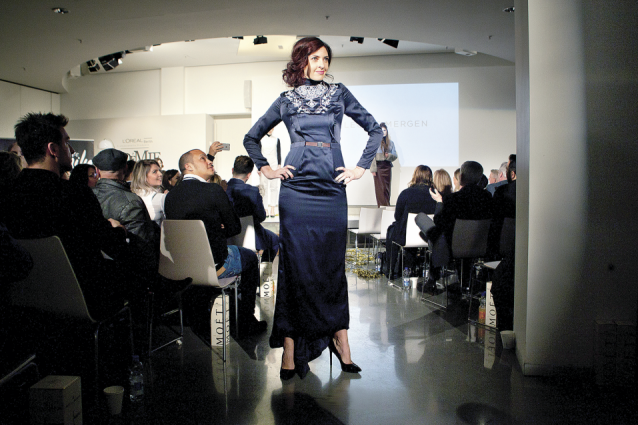 L’Oréal fashionistas were excited, intrigued and fascinated by this sideways – yet undeniably wearable – series of 26 Karabakh-Collection ‘looks’ from the sketchpad of the talented Leonie Mergen. Photo: Henrik Jordan
L’Oréal fashionistas were excited, intrigued and fascinated by this sideways – yet undeniably wearable – series of 26 Karabakh-Collection ‘looks’ from the sketchpad of the talented Leonie Mergen. Photo: Henrik Jordan
Were you first introduced to Azerbaijani designs and fashions when undertaking your internship at EDSOR-Berlin five years ago?
Indeed – we were working on a project entitled the Karabakh-Azerbaijan range that took the patterns from Karabakh carpets that were applied to scarves, ties and pochettes. They were all made of silk.
What led you to become interested in creating the Karabakh-Collection?
The Karabakh-Azerbaijan range only focused on scarves, ties and pochettes, and I felt this was a shortcoming, when compared to the cultural richness of the region. I felt there was scope to develop an entire collection of pieces that not only focused on ethnic patterns, but also on traditional clothing and national symbols, such as the pomegranate.
Altogether there are 26 looks, distilled from over 500 initial sketches, my intention being to make each look very individual and instilling an element of individuality to each piece. I wanted to avoid any looks from being too close to each other, yet there needed to be continuity throughout the line.
From what materials are the Karabakh-Collection made?
They are solely made of natural materials, including wool, leather, silk and fur – the original materials from the region that were used in historical clothing. The entire Karabakh-Collection was made in Germany, although the distinctive boots were manufactured in Azerbaijan.
For how long were you working on the collection?
I worked on the collection for an extraordinary time period. I tried to design and manage every element myself. I undertook all the designing, patternmaking and oversaw the production. In total, I worked on the collection for over two years.
From where did you get your information on Karabakh traditional garments?
I visited Azerbaijan on numerous occasions on fact-finding missions and visited all the main museums – most notably the carpet museum – and was provided with archive access. I collected a great deal of research materials from books and by studying historical clothing.
Both the Karabakh-Collection and Public Boudoir collection have taken inspiration from the past. What are the challenges when synthesising ancient and contemporary clothing?
On this occasion, the challenge was to take the traditional Karabakh carpet patterns and to modernise them so they are wearable. The carpet patterns are very rich and strong and the designer does not want to change them, yet it is necessary to produce clothes that are wearable in an everyday context.
Who do you see as the potential customers for the collection?
I have received very positive feedback from Azerbaijan and there have been enquiries about buying some of the looks. I feel there is great scope for custom emanating from Azerbaijan. I am building an online shop at the present time, and I am speaking to various shops in Berlin about stocking the collection.
Why was it particularly important that the Karabakh-Collection was exhibited in Berlin and London? Did you also want to raise awareness about the current status of Nagorno-Karabakh?
Yes, I think it is essential to stress that Karabakh and its cultural heritage is an integral part of Azerbaijan and to bring this message to as many cities as possible.
Where do you see the Karabakh-Collection being exhibited in the future?
I would be delighted to bring it to Azerbaijan for the Baku Fashion Week, in addition to other important European fashion weeks, such as those in Brussels and Milan.
About the author: Neil Watson is chief editor of TEAS Magazine.